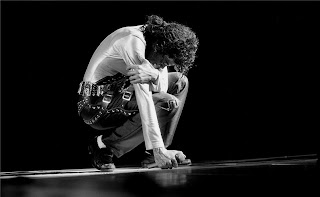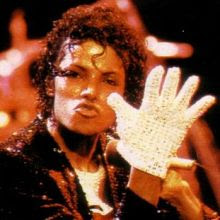Saturday, May 15, 2010
Tuesday, February 9, 2010
Graffiti Culture
Sunday, November 8, 2009
Bigger than an Entertainer
 Michael Jackson is inextricably the most loved artist around the world. He was much bigger than an entertainer. He did more than entertain. His creative work proceeded time and extended beyond popular. The title "Pop star" is too small for his ingenious and lacks the true creative depths and honor. Michael Jackson was a true artist in every sense of the word.
Michael Jackson is inextricably the most loved artist around the world. He was much bigger than an entertainer. He did more than entertain. His creative work proceeded time and extended beyond popular. The title "Pop star" is too small for his ingenious and lacks the true creative depths and honor. Michael Jackson was a true artist in every sense of the word. Sunday, November 1, 2009
The White Glove Effect

Michael Jackson's wearing one white glove has done much for the preservation of art. In the art world, wearing white gloves is ideal for the safe handling of art work. According to Chicago Sun-Times, "Mike's glove infatuation came at a Hollywood production studio in 1980 when he noticed an editor handling film with a single white glove to keep smear marks off. The young star was intrigued."
Whether film, photo, painting, or whatever type of art, preservation is important. Art records the history of a culture, a period in time, through the experience of that artist. Many artworks have been around for centuries because they have been handled with white gloves.
It may seem harmless to touch the artwork just a little bit but the unseen oils and dirt on fingertips can be transferred to the artwork and cause great damage. Never touch the surface of an unframed artwork without gloves; even clean hands leave a corrosive residue.
Anyone selling or dealing with art will wear white gloves when handling it. Great care has to be taken to preserve the artwork.

Artwork is very valuable. Many artists are no longer around to create anymore and share their point of view with the world so it is vital great care is taken in handling the art.
Michael Jackson saw something deeper when he watched how film was carefully being handled. He transferred that love, appreciation, and respect for art preservation to his own image.
Your Brain on Color

This is Your Brain on Drugs COLOR
Color is a powerful psychological tool. Color can send a positive or negative message, calm, excite, or stimulate. Commercial artists (i.e Graphic
designers, Web designers )must especially be aware of the effect of color on the brain as they deal with consumers. Companies spend a lot of money on color market research. For instance most fast food restaurants are decorated with vivid reds and oranges. Studies show that reds and oranges encourage people to eat quickly and leave. Jaguars website is predominantly black to make people feel sophisticated and prestigious. You can't escape color. Color often controls unconsciously. In Nort
h American mainstream culture, certain colors are associated with certain qualities or emotions.
Black is the color of authority and power. It is associated with intelligence (PhD graduates wear black robe; black horn rimmed glasses, etc.) It's a somber color associated with grieving. It i makes people appear thinner. It is also sophisticated, stylish and timeless. Black also implies submission (Priests). Black can be overpowering, or make the
wearer seem evil. Villains such as Dracula and the bad guy wear black.
For most of the world white is the color associated with purity (wedding dresses); cleanliness (doctors in white coats, using white gloves to touch art) It is also used to project the absence of color. White is associated with creativity (blank canvas). It is a compression of all the colors in the color spectrum.
If you want to get attention, use red. It is often where the eye looks first. Red is the most emotionally intense color and get people excited. Red is the color of energy. Red stimulates a faster heartbeat and breathing. Red is used in restaurant decorating schemes because it is an appetite stimulant. People wearing red clothing gets noticed. Since it i
s an extreme color, red clothing might not help people in confrontations. Red would not be a good color for a baby's room or to paint prison walls. Insurance is higher on red cars. Studies show red cars are popular targets for thieves and get more speeding tickets. It is not good to overuse red but using a spot of red in just the right place is smart.
Pink is just the opposite of red. Pink is the most calming of all colors. Dangerous criminals are housed in pink cells as studies show that pink drains the energy,calms aggr

ession, and is soothing and tranquilizing. Sports teams sometimes paint the locker rooms used by opposing teams bright pink so their opponents will lose energy.
Much of the world is
blue (skies, seas). Blue is peaceful and tranquil and seeing the color blue causes the body to produce calming chemicals in the brain. People tend to be more productive in a blue room because they are calm and focused. Studies show weightlifters are able to handle heavier weights in blue gyms. Blue has become associated with steadfastness, dependability, wisdom and loyalty (Blue uniforms). While blue is one of the most popular colors it is one of the least appetizing.
It is the easiest color on the eye. Green is a calming color that's very pleasing to the senses. Green is seen as tranquil and refreshing, calming, and tranquil. People waiting to appear on TV sit in "green rooms" to relax. Green is considered the color of peace and nature.
Yellow is cheerful and associated with good times. A person surrounded by yellow feels optimistic because the brain release more feel good chemicals around this color. It is the color associated with optimism Cheerful sunny yellow is an attention getter. Yellow will advance from surrounding colors. While it is considered an optimistic color, Yellow is mentally stimulating, and activates memory and concentration (think about yellow legal pads). In the New York City, taxi cabs are yellow to catch attention.
But be careful with yellow, Yellow is the most difficult color for the eye to take in, so it can be overpowering if overused. Tempers flare and people lose their cool more often in yellow rooms.
Brown is the color of earth and is plentiful in nature. Brown is associated with things being natural or organic. Brown is an approachable color and gives the feeling of wholesomeness.
Not Astrology but Colorology
Ancient cultures practiced chromotherapy, or using colors to heal. Colors can impact the body's energies. They can help to clear negative emotions and energy and restore balance. Chromotherapy is sometimes referred to as colourology and is still used today as a holistic or alternative treatment. Some tools used in color therapy include gemstones, candles, prisms, colored fabrics, bath treatments, and colored eye wear.
Sunday, October 18, 2009
Sunday, October 11, 2009
Visual Culture Rules the World














